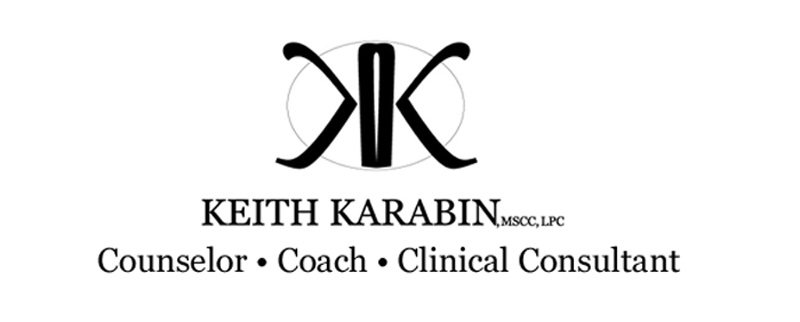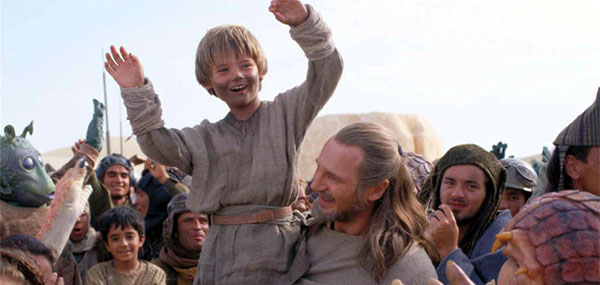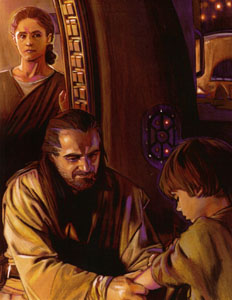Balance to the Force: Harnessing Counseling Assessment
“You were the chosen one! It was said that you would destroy the Sith, not join them. You were to bring balance to the force, not leave it in darkness.”
– Obi-Wan to Anakin, Revenge of the Sith
Counseling today, often seen as a nearly exclusively verbal practice—sometimes involving a cryptic note taking on a pad—is now very different than it began in the 20th century when “many people viewed the terms counseling and assessment as being synonymous and…most of the public thought counseling always involved the use of tests” (Whiston, 2013, p.3). This focus shift actually reminded me of a discussion that I had with my oldest friend about the use of Midi-chlorians in the Star Wars 1-3. I thought it was a Lucasian jumping of the shark, but he convinced me that, actually, it showed how far from the “faith” of the Force the Jedi had fallen, and too far into the science of assessment and technology, thus the “balance” Anakin was bringing back to the Force was a return to faith and humanity.
This is echoed by the possibility that the shift in counseling since the 1930s may have been due to the growing positive emotion-focused Humanistic movement of the 1950s and away from analysis and behavioral approaches. But, as I hope we’re seeing in the new movies, the well-rounded, ethical counselor—or the balanced Jedi in movies 7-9—need not choose between emotional approaches and a tradition of assessment that has been around since proficiency testing used in China in 220 BC, because “assessment is not just used for gathering data…it is a tool through which counselors are able to measure such human constructs as emotion, intelligence, personality, self-esteem and aptitude” (Nagel, 2009, p. 32).
To have a tool at our disposal that can measure the indefinable essence of man and harness it to help clients heal is profound. Assessments are, in fact, crucial to providing the most holistic care for clients, but that use of assessment must be equally holistic one, which “simultaneously considers a host of…characteristics,” strengths and challenges, rather than building a treatment plan “based on a single characteristic” usually the presenting problem. This was observed by Sangwon Kim and others, in their research of how one of the most universally employed assessments, the Behavior Assessment System for Children (BASC-2), is a valuable tool, but is best balanced by supplementary methods, especially when used with high-risk or minority teens (2010, p.525).
What’s in a BASC?
“His cells have the highest concentration of midi-chlorians I have seen in a life-form. It was possible he was concieved by the midi-chlorians.”
– Qui-Gon Jinn, The Phantom Menace
The Behavior Assessment System for Children (BASC) was created in 1992 by Reynolds and Kamphas “through a careful examination of the theoretical literature,” review of other scales and assessments, and “extensive clinical consultation.” The result was a “multimethod, multidimensional system intended to assess…emotional and behavioral disorders” in people age 2 to 25. In 2004, after extensive use and feedback, the BASC was revised as the BASC-2 to identify “negative and maladaptive behaviors” but balance them with “scales in Functional Communication, Activities of Daily Living [and] Adaptability (Stein, 2007 p.1-2). But many have found that assessments like the BASC-2 still focus primarily on problem behaviors and relegate strengths to “questions or subscales” that “are limited in number and scope” (Buckley and Epstein, 2004, p. 21).
Criticism aside, the BASC-2 rightly remains in use in counseling offices and schools throughout the world as one of the go-to assessments in treatment planning, assisting with DSM-IV and DSM V diagnoses, defining if problem-behavior is the result of physical or developmental disability, forensic evaluation and ongoing research.
When All You Have is a Lightsaber
“I believe you will bring balance to the Force. That you will face your demons and save the universe.”
– Qui-Gon Jinn, The Phantom Menace
It is the ethical role of a counselor in therapy to not just use assessment, but use right ones at the right times, for the right clients. The American Counseling Association requires that “counselors carefully consider the validity, reliability, psychometric limitations, and appropriateness of instruments…and, when possible, use multiple forms of assessment…in forming conclusions, diagnoses, or recommendations” (ACA, 2014, p.11).
 Thus, while a BASC-2 is a fine assessment to complete in terms of case conceptualization, when it comes to the role of strength-based treatment planning, or “developing strengths and enhancements of well-being, while at the same time not ignoring weakness…the importance of assessing strengths, resources, and healthy processes cannot be overstated” and merits a balanced approach (Whitston, 2013, p. 289).
Thus, while a BASC-2 is a fine assessment to complete in terms of case conceptualization, when it comes to the role of strength-based treatment planning, or “developing strengths and enhancements of well-being, while at the same time not ignoring weakness…the importance of assessing strengths, resources, and healthy processes cannot be overstated” and merits a balanced approach (Whitston, 2013, p. 289).
This approach may help counter an alarming statistic. Baseline BASC-2 scores are built on national norms, separated by age group, gender or clinical status and “general norms closely reflect the US population estimates for race and ethnicity” gender and parent education (Stein, 2007, p.2) but only 53% of the national sample of those taking BASC-2 were found to be average or well adapted in terms of their strengths (Kim, 2010). A balanced strength-identification approach is even more important with adolescents in high-risk lifestyles, socioeconomic groups or with present-high risk behaviors of whom Kim found only 41% fall in the two positive clusters (2010).
As counselors we are to “place test results in proper perspective with other relevant factors” (ACA, 2014, p.12) and while the BASC-2 is a robust system for helping gain an understanding of the problems, and some strengths, of our clients, it may not be best suited for building a holistic solution, as Stein observed that “it tells the practitioner next to nothing about treatment implications” (2007, p.5). Qwi-Gon may have done well to notice Ani’s full measure of strengths and weaknesses when he focused on helping him harness his power.
Brining Balance to the Force. Again.
“That’s not how the Force works!”
– Han Solo, now a believer in the Force, The Force Awakens
When we look at treatment planning we return to the picture of the modern counselor, the post-Humanist, the  problem solver and strength-builder. Assessment is vital in both determining the problems to solve and the strengths to solve them, but the BASC-2 has seven clusters of behaviors, of which two Kim (2010) considered the positive ones. Stein agreed, asserting that “The BASC-2 is still just one piece (albeit a hefty piece) of the diagnostic picture” and not the sole provider of a total “comprehensive evaluation of behavior, personality and context” which she considered “a strong claim” made by Reynolds and Kamphas. Stein urged counselors to seek out “multiple OTHER measures” (her emphasis) including a better way to examine diverse client’s problem behaviors in their normal environments as well as classify them in a more individualized way (2007, p.5). Her focus on being individualized and personal in the assessment of diverse patient needs fits well within the role of a holistic ethical counselor.
problem solver and strength-builder. Assessment is vital in both determining the problems to solve and the strengths to solve them, but the BASC-2 has seven clusters of behaviors, of which two Kim (2010) considered the positive ones. Stein agreed, asserting that “The BASC-2 is still just one piece (albeit a hefty piece) of the diagnostic picture” and not the sole provider of a total “comprehensive evaluation of behavior, personality and context” which she considered “a strong claim” made by Reynolds and Kamphas. Stein urged counselors to seek out “multiple OTHER measures” (her emphasis) including a better way to examine diverse client’s problem behaviors in their normal environments as well as classify them in a more individualized way (2007, p.5). Her focus on being individualized and personal in the assessment of diverse patient needs fits well within the role of a holistic ethical counselor.
A measure that may supplement the BASC-2, to overcome the deficit in treatment planning data, while also building therapeutic alliance and strength-based solutions is the Behavioral and Emotional Rating Scale–2 (BERS-2) because it “has emerged as a widely used standardized instrument designed solely to assess children’s emotional and behavioral strengths…developed in response to the paradigm shift away from a deficit-only focus to the enhancement of students’ strengths” (Buckley and Epstein, 2004, p. 22).
Buckley noted that this metric was as sound as the BASC-2 in terms of validity and reliability, and overlapped some of the problem assessment areas, but with a focus on “the enhancement of student functioning, not just the reduction or elimination of deficits.” Processing this assessment as a rapport-building tool can bring the data from the BASC-2 into a treatment planning “positive parent-child-professional relationship” where the “focus of the communication is on what the child does well, or how to increase the child’s strengths” (2004, p.25).
If the use of assessment began to decline as the focus on Humanistic, strength-based approaches rose, then that same desire can bring the use of assessment back into balance in our present-day counseling offices. Ethical counseling incorporates diverse assessment and treatment for diverse clients with the same universal goal: to live well. This goal is reached in honest awareness of what we must overcome, but also, by harnessing the Force within us to overcome it.
__________________________________________________
American Counseling Association. (2014). ACA code of ethics. Retrieved from http://www.counseling.org/Resources/aca-code-of-ethics.pdf
Buckley, J. and Epstein, M. (2004) The Behavioral and Emotional Rating Scale–2 (BERS-2): Providing a Comprehensive Approach to Strength-Based Assessment. The California School Psychologist, Vol. 9, pp. 21-27.
Kim, S. (2010) A Typology of Behavioral Adjustment in Ethnically Diverse Middle School Students. Journal of Psychoeducational Assessment.
Stein, S. (2007). Review of the Behavior Assessment System for Children [Second Edition]. In K. F. Geisinger, R. A. Spies, J. F. Carlson & B. S. Plake (Eds.), The seventeenth mental measurements yearbook. Lincoln, NE: Buros Institute of Mental Measurements.
Whiston, S. C. (2013). Principles and applications of assessment in counseling (4th ed.). Belmont, CA: Brooks/Cole.



